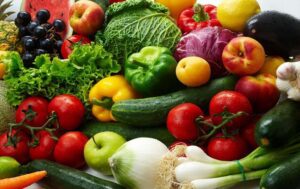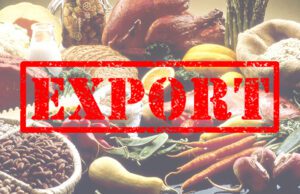
Ukraine exported 7.0 million tons of agricultural products in December 2022, down 2% from the previous month, the Ukrainian Agribusiness Club (UCAB) said on its Facebook page on Monday.
“3% of these exports were made through the “grain corridor”, the rest through alternative export routes. However, it is necessary to take into account that not all products had time to physically cross the border. A lot of products are now in line for export both by rail and road transport, which will negatively affect exports by alternative routes next month”, – Association specifies in its report.
UCAB noted that 4.9 million tons of crops were exported in December 2022, which is 4% more than in November. By crops, 3.09 million tons of corn (63% of total), 1.67 million tons of wheat (34%) and 147 thousand tons of barley (3%) were exported to foreign markets.
Ukraine also exported 868 thousand tons of oilseeds during this period – a third less than in November. Ukraine exported 295 tons of sunflower seeds (34%), 251 tons of soybeans (29%) and 217 tons of rapeseed (25%).
UCAB also noted that exports of vegetable oils in December fell by 9% against the previous month – down to 468 thousand tons, 94% of which was sunflower oil (440 thousand tons) and 6% soybean oil (29 thousand tons). In turn, exports of sunflower and soybean cake and meal increased by 58% to 506 thousand tons, including 90% of sunflower waste (455 thousand tons) and 10% of soybean oil (51 thousand tons).
“The greatest changes in the structure of exports in December 2022 are associated with a decrease in export shipments of oilseeds, which showed a drop of one-third from the previous volumes. This is primarily due to a decrease in export volumes of rapeseed. The rape grown in 2022 and intended for export is almost completely exported, there will be no significant shipments of this crop until next year’s harvest”, – UCAB stressed in the report.
However, the reduction in rapeseed exports will allow for increased shipments of other crops, particularly oilseed cake.
“In any case, Ukraine still has a significant amount of products destined for export, and there is a stable demand for Ukrainian agribusiness products in the world market. With current export volumes, it is gradually possible to take out stocks of grown products and partially generate foreign exchange earnings. The prices in Ukraine are still low, and logistics costs “eat up” the entire profit of the agrarians, which in turn jeopardizes the sowing season 2023″, the organization stated in its report.
As previously reported UCAB, Ukraine exported 7.2 million tons of agricultural products in November 2022, in October and September – 6.9 million tons, in August – 4.6 million tons, in July – 3.0 million tons and in June – 2.7 million tons. According to the Ministry of Agrarian Policy of Ukraine, in May agricultural exports amounted to 1.74 million tons, in April – 0.96 million tons and in March – 0.33 million tons.
Prior to the full-scale military invasion by the Russian Federation, Ukraine exported on average 5-6 million tons of agricultural products per month, mostly through its maritime infrastructure in the Black Sea.

Ports of “Big Odessa” last Saturday and Sunday dispatched 390 thousand tons of agricultural products within the framework of the “Grain Initiative”, the Ministry of Infrastructure of Ukraine reported.
“For the last two days, nine ships left the ports of “Big Odessa” to deliver 390 thousand tons of agricultural products to Africa, Asia and Europe, including bulk carriers ALANDA STAR and SSI PRIVILEGE with 68 thousand tons of wheat for Egypt and Indonesia, as well as tanker EUROCHAMPION with 45 thousand tons of vegetable oil for India,” the Ministry noted.
The Ministry notes that 24 ships are being processed at the ports, involved in the “grain initiative. They load more than 860 thousand tons of Ukrainian agricultural products.
“Grain corridor” also moves three vessels for the loading of 93 thousand tons of agricultural products.
At the same time, 99 ships are waiting for inspection in the Bosporus, 72 of which – to enter the ports for loading, 27 – already with Ukrainian agricultural products.
“Russia’s goal is to slow down the process of vessel inspections. First they reduced the number of inspection teams to three, now they started to drag out the time of inspections themselves. Representatives of the Russian Federation have started to check even indicators that are not stipulated in the documents of the SKC and have nothing to do with the subject of the inspection (for example, whether judicial units work well, how much fuel, etc.),” explains Deputy Minister of Community, Territory and Infrastructure Development Yuriy Vaskov.
According to him, under this algorithm, the inspection of a single ship takes four hours, which leads to a longer queue and at the same time a million losses for the cargo owners because of downtime.
According to the Ministry of Infrastructure, as of December 25, inspection group #3 had not held a single inspection, resulting in only six inspections per day out of 10 scheduled.
The agency noted that for continuous movement of grain corridor should be held at least 12 inspections per day.
In total, since August 1, 594 ships left the ports of Greater Odessa, which exported 15.5 million tons of Ukrainian food to Asia, Europe and Africa.

Over 15 million tons of agricultural products were exported from Ukraine during the “grain deal”, Minister of Transport and Infrastructure of Turkey Adil Karaismailoglu said.
“According to the minister, from the first of August to December 25, 585 dry cargo ships departed from Ukrainian ports. A total of 15 million 80 thousand tons of 13 varieties of agricultural products were transported through the “grain corridor,” he said,” reports Anadolu.
He noted that 44% of the products coming from Ukraine were sent to European countries, 29% – to Asian countries, 15% – to Turkey and 12% – to African countries.
On July 22 in Istanbul with the participation of the UN, Russia, Turkey and Ukraine signed documents to create a corridor for the export of grain from three ports in the Ukrainian territory – Chornomorsk, Odessa and Yuzhny.

With the beginning of a full-scale Russian invasion, A.G.R. Group. Group and MK Merchants SA, owned by businessman Misak Khidiryan, reoriented logistics routes from Ukrainian seaports to the EU market via road and rail transport as well as the river ports of Reni and Izmail.
Misak Khidiryan told Interfax-Ukraine news agency that the group of companies will continue to export part of its agricultural products through the land border crossings with the EU and along the Danube River even after the liberation of the occupied territories from the Russian troops and Ukraine’s resumption of full trade in the Black Sea.
According to his data, after the full-scale war began, the group of companies searched for elevator facilities in Western Ukraine and transported crop stocks there from the central regions of the country. Later on, logistic channels by road and rail were established for the marketing of agricultural products in the European Union. The group of companies already has an agreement to cooperate with a European trading company with quite a powerful infrastructure throughout Europe, where they have already started supplying their agricultural products.
“In addition, we have agreed that we will work together to load their volumes and have given guarantees that after our victory and the liberation of the occupied territories, we will maintain our partnership, even when the ports are opened and maritime logistics are again a priority. Perhaps even consider with the board of the A.G.R. Group to buy new clusters in the West of Ukraine for a more convenient partnership,” Misak Khidiryan told the agency.
According to him, deep-sea ports are currently inaccessible for export, so road and rail transport is used, as well as Reni and Izmail ports. However, such logistics is much more expensive than sea exports, and it also involves a number of difficulties, such as the inability of drivers – its citizens – to travel outside Ukraine, or large queues of ships in the ports.
However, in addition to the European direction, activity in several countries of the Middle East has been stepped up. “Our offices are operating there and we are running domestic sales to the maximum, because we need additional margin due to high logistics costs. We have to clearly understand that the logistics leverage has increased, freight prices have gone up, energy and fuel prices have gone up, and as a result we are spending about $200 on a ton of exports. $200 on our commodity is a huge amount of money, we used to spend $45-50 per ton,” stated Misak Khidiryan.
Agroholding A.G.R. Group includes more than 20 companies. The main direction of its activity is trade in agricultural products, cultivation and storage of crops, as well as cattle breeding.
A.G.R. Group cultivates land in Poltava, Kiev, Chernigov, Nikolaev and Sumy regions. All grown products are sold on foreign markets.
The president of the holding and head of its supervisory board is businessman Misak Khidirian.
A.G.R.GROUP, agricultural cluster, AGRICULTURAL PRODUCTS, Khidiryan, Merchants, RIVER PORT'S

Since the beginning of a full-scale Russian invasion Ukraine has supplied to foreign markets 32.2 million tons of grain, pulses, oilseeds and their products, according to the website of the Ministry of Agrarian Policy and Food of Ukraine.
At the same time in November 2022 5.9 million tons of agricultural products were shipped from the country, which is 1 million tons less than in the first October and September. By crops, 1.6 million tons of wheat (20% less than in October) and 2 million tons of corn (13% less) were shipped from Ukraine during a month.
In turn, exports of sunflower oil in November compared to the previous month increased by 8%, to 466 thousand tons, sunflower seed – by 27%, to 377 thousand tons, soybean – by 67%, to 385 thousand tons, while shipments of rapeseed decreased by almost half, to 412 thousand tons, meal of all kinds – by 25%, to 344 tons, soybean oil – by 36%, to 16 tons.
According to the Ministry of Agrarian Policy, 34.3% of foreign shipments of agricultural products in November were corn, 26.8% – corn, 7.9% – sunflower oil, 7.0% – rape, 6.5% – soybeans, 6.4% – sunflower seeds, 5.8% – meal, 5.0% – barley, 0.3% – soybean oil.
In addition, in the first nine months of the war from Ukraine exported 12.3 million tons of corn (38.2% of the total), 7.0 million tons of wheat (21.8%); 2.8 million tons of rape (8.6%); 2.8 million tons of sunflower oil (8.6%); 2.4 million tons of sunflower seed (7.4%); 1.9 million tons of meal (5.8%); 1.5 million tons of barley (4.7%); 1.3 million tons of soybeans (4.2%) and 168 tys. tons of soybean oil (0.5%).
As reported, in October and September, Ukraine exported 6.9 million tons of agricultural products, in August – 4.6 million tons, in July – 3.0 million tons, in June – 2.7 million tons, in May – 1.74 million tons, in April – 0.96 million tons and in March – 0.33 million tons.
Before Russia’s full-scale military invasion, Ukraine exported an average of 5-6 million tons of agricultural products per month, mostly through its maritime infrastructure in the Black Sea.

Ukraine exported 7.2 million tons of agricultural products in November 2022, a 4% increase over the previous month, the Ukrainian Agribusiness Club (UCAB) said on its Facebook page on Monday.
According to the Association, it is a very good indicator, taking into account the difficulties with the operation of the grain corridor in November. During the month, it was possible to export 2.6 million tons of agricultural products, compared to 4.2 million tons in October, while the remaining volumes were exported by alternative routes.
UCAB noted that 4.7 million tons of crops were exported in November, which is 4% more than in October. By crops, 2.54 million tons of corn (54% of the total), 1.79 million tons of wheat (38%) and 376 thousand tons of barley (8%) were exported to foreign markets.
Ukraine also exported 1.3 million tons of oilseeds during this period, which is 10% more than in October. Ukraine exported 520 thousand tons of rapeseed (40%), 390 thousand tons of sunflower seed (30%) and 377 thousand tons of soybeans (29%).
UCAB also reported that exports of vegetable oils in November increased by 3% against the previous month – up to 515.8 thousand tons, 94% of which was sunflower oil (484 thousand tons) and 6% soybean oil (31 thousand tons). In turn, the export of sunflower and soybean cake and meal decreased by 21% to 342 thousand tons, including 88% of sunflower waste (300.1 thousand tons) and 12% of soybean oil (41 thousand tons).
“Problems in the operation of the “grain” corridor, caused by significant delays in inspections by the Russian side and the formation of queues of ships, force to focus again on the development of alternative routes, although this process has not stopped. However, we should take into account that the cost of logistics by alternative routes are many times higher than the cost of shipping from the ports of Odessa region, and just the sea route is the most cost-effective and efficient today,” – summarized UCAB in the message.
As previously reported by the Association, in October and September, Ukraine exported 6.9 million tons of agricultural products, in August – 4.6 million tons, in July – 3.0 million tons, in June – 2.7 million tons. According to the Ministry of Agrarian Policy of Ukraine, in May agricultural exports amounted to 1.74 million tons, in April – 0.96 million tons and in March – 0.33 million tons.
Prior to the full-scale military invasion by the Russian Federation, Ukraine used to export an average of 5-6 million tons of agricultural products per month, mainly through its maritime infrastructure in the Black Sea.